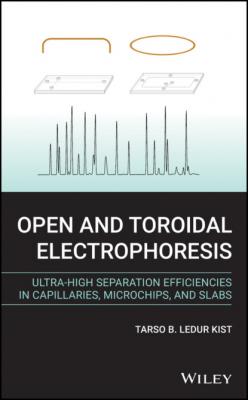Скачать книгу
of the detectors that are compatible with the open layout are also compatible with the toroidal layout. They are presented in
Chapter 8, which also includes the following detection systems: absorption, contactless conductivity, fluorescence, thermal lens, and mass spectrometry. Many advantages of fluorogenic and labeling reactions in both the open and toroidal layouts are presented. In addition, the use of these reactions to increase the detection limits, performance indicators, and separation selectivities is also discussed.
In Chapter 9 a few examples of the applications of the toroidal layout are presented. These include the analyses of amino acids, stereoisomers, and isotopomers, among others. The potential of toroidal electrophoresis to obtain separation efficiencies of over one hundred million theoretical plates is shown and discussed. This is the only chapter that omits the open layout, as it would be almost impossible to present all of its applications (across all platforms and separation modes) in a single book.
Important mathematical deductions pertaining to the ESTs are made in the appendixes. These deductions have been left for the appendixes to make the main text more fluidic and light.
1 Solvents and Buffer Solutions
1.1 Water as a Solvent
Water is by far the most widely used solvent in the preparation of gels, linear polymer solutions, and buffer solutions for electrokinetic separation techniques (ESTs). This is because of its unrivaled capacity to dissociate and ionize a great variety of substances (salts, acids, and bases). Ultimately, due to the large number of reactions that occur within water, it is the substance that makes life possible. Therefore, there are many reasons to take a closer look at the interesting properties of this unique liquid.
1.1.1 Temperature and Brownian Motion
The temperature of a solvent, for instance water, acetonitrile or methanol, is related to the average energy per degree of freedom that these molecules have. Average energy is given by
, where represents the Boltzmann constant and represents temperature in Kelvin.[1] The degrees of freedom consist of the translation velocity, which occurs in the three space coordinates, and both the vibrational and rotational degrees of freedom of the molecules. Raising the temperature of liquid water at 1 atm from 278.15 K (5 C or 41 F) to 348.15 K (75 C or 167 F) increases the average velocity (), indeed , by about 25%. The consequential increase in thermal energy is important for the collision rate and momentum transfer among the molecules within the liquid. Such collisions with fast-moving molecules cause random movements of the microscopic particles that are suspended in the liquid (or in a gas), which can be observed under the microscope (Brownian motion). This is the basis for the denaturation and renaturation of nucleic acids, as well as the denaturation of proteins (disruption of both the secondary and tertiary structures). This same process also plays a role in dissolution, dissociation, ionization, and in maintaining the equilibrium of reactions. The Gibbs free energy change quantitatively gives the role of enthalpy, temperature and entropy for chemical reactions in the general case (see Section 1.1.8).
1.1.2 Electric Permittivity of Water
Water is a remarkable solvent for the dissolution, dissociation, and ionization of many substances. There are a few ways to predict these unique properties of water. The predictive models belong either to the classical theory of electromagnetism, statistical mechanics, thermodynamics, or the molecular dynamics simulations that use dedicated software to predict the physical movements of atoms and molecules (which are based on the fundamental Newton equations of mechanics). Above all, it must be remembered that oxygen has the second highest electronegativity of the whole periodic table [2] (see Figure 1.1). Only fluorine has a higher electronegativity; it forms only one covalent bond with a hydrogen atom (hydrogen fluoride) and is not liquid at room temperature (above 19.5
C). Nitrogen, the other neighbor of oxygen in the periodic table, forms three covalent bonds with hydrogen and undergoes sp3 hybridization, producing three sp3 bonding orbitals and one sp3 non-bonding orbital (forming ammonia). It is also a gas at room temperature. In water molecules, on the other hand, oxygen establishes covalent bonds with two hydrogen atoms. The resulting sp3 structure contains two bonding orbitals (with a partial positive charge at each hydrogen position) and two non-bonding orbitals (with a partial negative charge on each). This produces a large electric dipole moment, especially considering that this is a small molecule, which explains the high relative electric permittivity of water (a small molecule with a large electric dipole moment), as shown in Table 1.1. The large amount of hydrogen bonds per unit volume within bulk water plays an important role in many of its unique properties. For example, the relatively high values of surface tension, boiling point, thermal conductivity, and latent heat of evaporation, to name a few. The strength and directional feature of hydrogen bonds explains a few additional odd properties, e.g., the solid (ice) has a lower density than the liquid (water).
The relative electric (static) permittivity of water is represented by the constant
and has an important role in the Coulomb equation, equation 1.1. This constant is high for water and Table 1.1 shows a list for comparison. Moreover, the average number of hydrogen bonds between water molecules in pure water is much larger than the average number of hydrogen bonds within hydrofluoridic acid or ammonia, due to the symmetry of the two sp3 bonding orbitals and the two sp3 non-bonding orbitals of water molecules. This maximizes the average number of intermolecular hydrogen bonds – up to two as negative charge donor and two as negative charge acceptor – totaling up to four hydrogen bonds per molecule. Therefore, pure water is liquid from 273.15 K up to 373.15 K at 1 atm. The electric force () among ions within a liquid is given by:
(1.1)
where
represents the electric permittivity of the vacuum, represents the permittivity of the liquid (solvent), is defined as the relative permittivity, and
Скачать книгу

